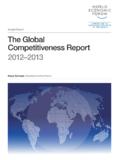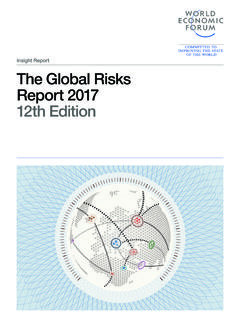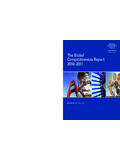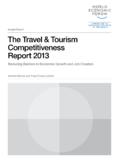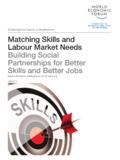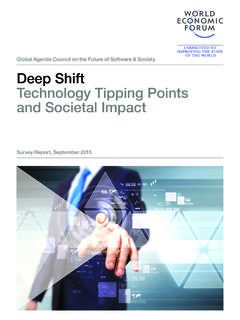Transcription of The Global Risks Report 2022
1 INSIGHT REPORTIn partnership with Marsh McLennan, SK Group and Zurich Insurance GroupThe Global Risks Report 202217th EditionThe Global Risks Report 2022, 17th Edition, is published by the World Economic information in this Report , or on which this Report is based, has been obtained from sources that the authors believe to be reliable and accurate. However, it has not been independently verified and no representation or warranty, express or implied, is made as to the accuracy or completeness of any information obtained from third parties. In addition, the statements in this Report may provide current expectations of future events based on certain assumptions and include any statement that does not directly relate to a historical fact or a current fact. These statements involve known and unknown Risks , uncertainties and other factors which are not exhaustive. The companies contributing to this Report operate in a continually changing environment and new Risks emerge continually.
2 Readers are cautioned not to place undue reliance on these statements. The companies contributing to this Report undertake no obligation to publicly revise or update any statements, whether as a result of new information, future events or otherwise and they shall in no event be liable for any loss or damage arising in connection with the use of the information in this Economic Forum Cover artwork: SMOG 2022 All rights rights reserved. No part of this publication may be reproduced, stored in a retrieval system, or transmitted, in any form or by any means, electronic, mechanical, photocopying, or otherwise without the prior permission of the World Economic : 978-2-940631-09-4 The Report and an interactive data platform are available at Global Risks Report 202217th EditionStrategic PartnersMarsh McLennanSK GroupZurich Insurance GroupAcademic AdvisersNational University of Singapore Oxford Martin School, University of Oxford Wharton Risk Management and Decision Processes Center, University of Pennsylvania The Global Risks Report 20224 Preface5 6 Executive Summary7 10 CHAPTER 1 Global Risks 2022.
3 Worlds Apartincluding Global Risks Perception Survey 2021 2022 Results11 29 CHAPTER 2 Disorderly Climate Transition30 44 CHAPTER 3 Digital Dependencies and Cyber Vulnerabilities45 56 CHAPTER 4 Barriers to Migration 57 69 CHAPTER 5 Crowding and Competition in Space70 79 CHAPTER 6 Refreshing Resilience80 91 AppendicesAppendix A: Description of Global Risks 2022 Appendix B: Executive Opinion Survey National Risk PerceptionsAppendix C: Technical Notes: Global Risks Perception Survey 2021 202292 112 Acknowledgements113 116 CONTENTSThe Global Risks Report 20225A divergent economic recovery from the crisis created by the pandemic Risks deepening Global divisions at a time when societies and the international community urgently need to collaborate to check COVID-19, heal its scars and address compounding Global some societies, rapid progress on vaccination, leaps forward on digitalization and a return to pre-pandemic growth rates herald better prospects for 2022 and beyond.
4 Others could be weighed down for years by struggles to apply even initial vaccine doses, combat digital divides and find new sources of economic growth. Widening disparities within and between countries will not only make it more difficult to control COVID-19 and its variants, but will also risk stalling, if not reversing, joint action against shared threats that the world cannot afford to year s edition of the Global Risks Report warned of potential knock-on economic Risks that are now clear and present dangers. Supply chain disruptions, inflation, debt, labour market gaps, protectionism and educational disparities are moving the world economy into choppy waters that both rapidly and slowly recovering countries alike will need to navigate to restore social cohesion, boost employment and thrive. These difficulties are impeding the visibility of emerging challenges, which include climate transition disorder, increased cyber vulnerabilities, greater barriers to international mobility, and crowding and competition in trust and fostering cooperation within and between countries will be crucial to addressing these challenges and preventing the world from drifting further 17th edition of the Global Risks Report identifies tensions that will result from diverging trajectories and approaches within and between countries and then examines the Risks that could arise from such tensions.
5 This year s Report also highlights the implications of these Risks for individuals, governments and Global Risks Perception Survey (GRPS), which has underpinned the Report since 2006, was refreshed this year to gather new and broader insights from nearly 1,000 Global experts and leaders who responded. The 2021-2022 GRPS includes the following sections: COVID-19 Hindsight invites respondents to opine on the reverberations of the crisis, allowing comparability with the results from the previous year. Future Outlook captures respondent sentiment, informing our analysis of how individual contexts may influence Global risk perceptions andaffect mitigation. Horizon captures respondents perceived trajectory and sense of urgency of Global Risks , informing our analysis of choices and trade-offs that decision-makers may face. Severity ranks potential damage while Effects asks respondents to consider cascading impacts in conjunction with the severity of the risk itself.
6 International Mitigation asks respondents to assess international efforts in 15 Global governance areas to identify achievements and areas of opportunity for Global action and cooperation. Open questions on Risks , trends and warning signs source expert Klaus Schwab and B rge BrendeThe Global Risks Report 20226 This year the Global Risks Report also draws on the views of over 12,000 country-level leaders who identified critical short-term Risks to their 124 countries, gathered through the World Economic Forum s Executive Opinion Survey. The areas highlighted in these responses are likely to inform national decision-making and provide a perspective on how short-term risk national priorities may compare with Global Risks and perspectives. We are ever grateful to our partners in the Report s development: Marsh McLennan, SK Group and Zurich Insurance Group. We also thank our academic partners: the National University of Singapore, the Oxford Martin School at the University of Oxford and the Wharton Risk Management and Decision Processes Center at the University of Report continues to leverage the collective intelligence of an expanding community of the world s foremost risk experts, convened by the World Economic Forum s Global Risks Practice.
7 The Global Risks Report Advisory Board, the Chief Risk Officers Community and the Global Future Council on Frontier Risks , as well as a series of consultations with regional and thematic experts from the public and private Report also draws from and supports the World Economic Forum s platforms dedicated to catalysing a new economy and society, accelerating climate action for people and planet, leveraging Fourth Industrial Revolution technologies, stewarding industry transformations and enhancing Global and regional cooperation. These platforms and their stakeholders use the insights from this Report to shape their agendas for tackling the world s greatest challenges and embedding greater resilience and Global Risks Report 20227As 2022 begins, COVID-19 and its economic and societal consequences continue to pose a critical threat to the world. Vaccine inequality and a resultant uneven economic recovery risk compounding social fractures and geopolitical tensions.
8 In the poorest 52 countries home to 20% of the world s people only 6% of the population had been vaccinated at the time of writing. By 2024, developing economies (excluding China) will have fallen below their pre-pandemic expected GDP growth, while advanced economies will have surpassed it by widening the Global income resulting Global divergence will create tensions within and across borders that risk worsening the pandemic s cascading impacts and complicating the coordination needed to tackle common challenges including strengthening climate action, enhancing digital safety, restoring livelihoods and societal cohesion and managing competition in Global Risks Report 2022 presents the results of the latest Global Risks Perception Survey (GRPS), followed by an analysis of key Risks emanating from current economic, societal, environmental and technological tensions. The Report concludes with reflections on enhancing resilience, drawing from the lessons of the last two years of the COVID-19 pandemic.
9 The key findings of the survey and the analysis are summarized Risks perceptions highlight societal and environmental concernsAsked to take a view of the past two years, respondents to the GRPS perceive societal Risks in the form of social cohesion erosion , livelihood crises and mental health deterioration as those that have worsened the most since the pandemic began. Only 16% of respondents feel positive and optimistic about the outlook for the world, and just 11% believe the Global recovery will accelerate. Most respondents instead expect the next three years to be characterized by either consistent volatility and multiple surprises or fractured trajectories that will separate relative winners and the next five years, respondents again signal societal and environmental Risks as the most concerning. However, over a 10-year horizon, the health of the planet dominates concerns: environmental Risks are perceived to be the five most critical long-term threats to the world as well as the most potentially damaging to people and planet, with climate action failure , extreme weather , and biodiversity loss ranking as the top three most severe Risks .
10 Respondents also signalled debt crises and geoeconomic confrontations as among the most severe Risks over the next 10 Risks such as digital inequality and cybersecurity failure are other critical short- and medium-term threats to the world according to GRPS respondents, but these fall back in the rankings towards the long term and none appear among the most potentially severe, signalling a possible blind spot in risk 2021-2022 GRPS included a question on international risk mitigation efforts. Artificial intelligence , space exploitation , cross-border cyberattacks and misinformation and migration and refugees are the areas where most respondents believe the current state of risk mitigation efforts fall short of the challenge that is, efforts are not started or in early development . Meanwhile, for trade facilitation , international crime and weapons of mass destruction , large majorities perceived risk mitigation efforts to be established or effective.
